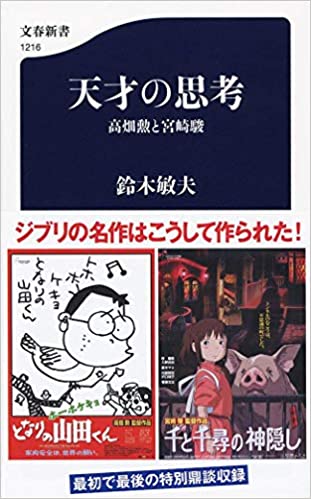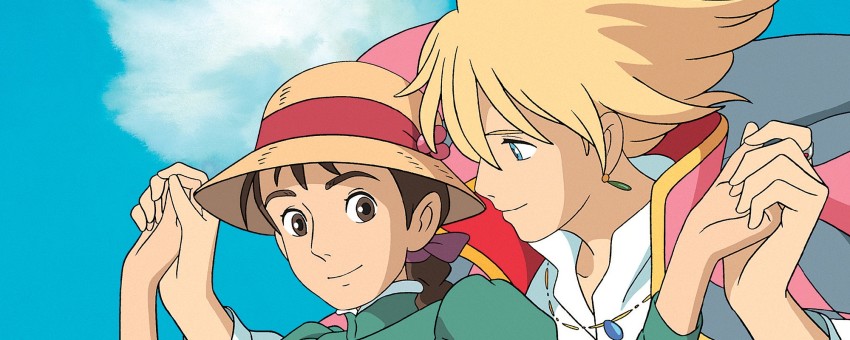Books: How Geniuses Think
August 20, 2020 · 0 comments
By Alex Dudok de Wit.
 The filmographies of Isao Takahata and Hayao Miyazaki, the two geniuses of this book’s title, stand as monuments to their creativity. But how do we weigh the achievement of Toshio Suzuki, the third man at the head of Studio Ghibli? Suzuki’s influence on Ghibli is hard to summarise because it is all-pervasive, at once macro and micro: he has overseen the studio’s operational side, devised its marketing campaigns, produced most of its films, provided calligraphy for their posters, and even helped Miyazaki shade and texture his manga Nausicaä of the Valley of the Wind.
The filmographies of Isao Takahata and Hayao Miyazaki, the two geniuses of this book’s title, stand as monuments to their creativity. But how do we weigh the achievement of Toshio Suzuki, the third man at the head of Studio Ghibli? Suzuki’s influence on Ghibli is hard to summarise because it is all-pervasive, at once macro and micro: he has overseen the studio’s operational side, devised its marketing campaigns, produced most of its films, provided calligraphy for their posters, and even helped Miyazaki shade and texture his manga Nausicaä of the Valley of the Wind.
Lately, as Ghibli slips into what may be its autumn years, Suzuki has devoted much of his copious energy to the orchestration of its legacy. A theme park here, a global streaming deal there. Less visible, at least outside Japan, has been the publication of various memoirs and anecdotal accounts of his forty-odd years in the company of Miyazaki and Takahata. Only one of these has come out in English to date (as Mixing Work with Pleasure: My Life at Studio Ghibli, a somewhat digressive set of portraits of the studio’s main players). Here’s another that should.
How Geniuses Think: Isao Takahata and Hayao Miyazaki is structured as a chronological walk through Ghibli’s catalogue, each chapter offering a production history of one film, presented against the backdrop of the studio’s circumstances at that time. These texts originally appeared in Ghibli’s marvellous “textbooks”, anthologies of critical commentaries and staff reminiscences about individual features. It makes sense to package them together: How Geniuses Think effectively functions as a linear history of the studio, or at least Suzuki’s version of it. In detail and with remarkably little repetition, it tracks the evolution of Ghibli’s practices, of its directors’ careers, and – most vividly – of Suzuki’s own talents.
 At the start of the book, Suzuki is a green young journalist at Ghibli’s parent company Tokuma Shoten, so ignorant of animation that he has to be schooled in the basics by a bunch of teenage girls. By the end, he is the most successful producer in anime history, looking ahead to Miyazaki’s current production How Do You Live?, and wistfully reflecting on those cultural trends that are beyond his control. Before toasting Ghibli’s long life, fans should heed Suzuki’s observation that audiences are tiring of the kind of allegorical fantasy films in which the studio excels. That, he explains, is one reason why he decided to shut the place down in 2013 – before Miyazaki kicked it back into gear with his new project.
At the start of the book, Suzuki is a green young journalist at Ghibli’s parent company Tokuma Shoten, so ignorant of animation that he has to be schooled in the basics by a bunch of teenage girls. By the end, he is the most successful producer in anime history, looking ahead to Miyazaki’s current production How Do You Live?, and wistfully reflecting on those cultural trends that are beyond his control. Before toasting Ghibli’s long life, fans should heed Suzuki’s observation that audiences are tiring of the kind of allegorical fantasy films in which the studio excels. That, he explains, is one reason why he decided to shut the place down in 2013 – before Miyazaki kicked it back into gear with his new project.
Suzuki’s constant dialogue with the zeitgeist forms the most engaging thread in the book’s narrative. For all that Miyazaki and Takahata are celebrated as auteurs, Suzuki has had a big hand in choosing and shaping their projects. Some of his calls are motivated by arrestingly trivial factors: he relates that he started contemplating an adaptation of the manga My Neighbours the Yamadas simply because its title echoed My Neighbour Totoro. More often, he is guided by an intuitive feel for the public mood. Thus he brings the novel When Marnie Was There to director Hiromasa Yonebayashi because it tackles “the questions of the self faced by people today.” When marketing Spirited Away, he puts the ghostly No Face front and centre, as the character embodies the “darkness” that has overcome Japan in the era of economic stagnation.
Of course, Suzuki’s success lies not only in reading the times, but in shaping them, too. He has helped to propel film after film to the heights of the Japanese box office and into the collective imagination. Here, he takes us behind the scenes of his epic marketing campaigns, detailing both the corporate tussling and the visionary leaps of faith required to pull them off.
These sections serve as a corrective to any notions that Ghibli’s films have done so well through sheer creative merit. Yes, Spirited Away may be the highest-grossing film of all time in Japan, but publicity-wise it also received what Suzuki calls “the biggest nationwide campaign” in the country’s history. This fact bothered Miyazaki himself. Suzuki remembers him collaring colleagues and asking them whether the film triumphed because it was good or well-marketed; the terrified staff assured him it was the former. Nor is Suzuki overselling himself: his brilliance as a business strategist has been corroborated elsewhere – most recently in a massively entertaining memoir by Steve Alpert, Ghibli’s former head of international sales.
Elsewhere, we read about Suzuki’s efforts to sustain productivity at the studio and keep the peace among its members. There are enlightening passages on Yonebayashi and Miyazaki’s son Goro, the two young directors hired to keep Ghibli’s slate full, without threatening the privileged positions of Takahata and Miyazaki Senior. Suzuki is frank about their roles, describing them as “professional directors” who are better at managing teams than the elder pair, but less inspired as artists. Yet he respects their right to a measure of authorial control, going as far as to sequester Yonebayashi in a secret location while he works on the storyboard for Arrietty in order to shield him from Hayao Miyazaki’s meddling.
Ultimately, the measure of Suzuki’s importance emerges in details like these, which show what it has taken to shape and manage this strange creative powerhouse. Contrary to the book’s title, we don’t learn much about how Miyazaki and Takahata think; for that, the reader is better off with the directors’ own collected writings (although Takahata’s have yet to be translated). Suzuki’s descriptions of the pair, while enjoyably candid at times, aren’t wholly surprising: we know that Miyazaki is equal parts curious and rude, resolute and needy, or that Takahata’s intellectual rigour and pedantry have a way of derailing his production schedules. The two famous directors aren’t really the subject of this book. Rather, it is Suzuki’s own genius that is revealed.
 In addition, How Geniuses Think is a gold mine of glittering anecdotes, many of which have not yet entered the echo chamber of Anglophone Ghibli lore. We learn that Suzuki and Miyazaki agreed to make Howl’s Moving Castle (pictured) while urinating next to one another in the studio toilets, and that Miyazaki initially asked Takahata to direct his pet project Totoro, only for Takahata to reply that he had no interest in being “sandwiched” between a Miyazaki script and Miyazaki designs. The book was not written by Suzuki but rather transcribed from interviews he gave in private, and this approach results in a breezy, humorous tone that suits the first-person voice.
In addition, How Geniuses Think is a gold mine of glittering anecdotes, many of which have not yet entered the echo chamber of Anglophone Ghibli lore. We learn that Suzuki and Miyazaki agreed to make Howl’s Moving Castle (pictured) while urinating next to one another in the studio toilets, and that Miyazaki initially asked Takahata to direct his pet project Totoro, only for Takahata to reply that he had no interest in being “sandwiched” between a Miyazaki script and Miyazaki designs. The book was not written by Suzuki but rather transcribed from interviews he gave in private, and this approach results in a breezy, humorous tone that suits the first-person voice.
Along the way, we’re treated to cameos from peripheral figures in the studio’s story. Some are well known – Hideaki Anno, Mamoru Oshii, Sunao Katabuchi – some less so. Suzuki is full of praise for the screenwriter Keiko Niwa, whose claim that she works well with Miyazaki because she “understand[s] how geniuses think” gives the book its title. He’s also complimentary about Nobuo Kawakami, the mysterious tech entrepreneur who pays visits to the production of From Up on Poppy Hill for reasons that remain vague. Suzuki recalls that Kawakami got on well with Miyazaki and others; anyone who’s seen the viral video in which Miyazaki excoriates Kawakami’s dodgy CG software pitch will suspect that Suzuki is being diplomatic.
Some films are missing. There are no chapters on The Cat Returns, the TV feature Ocean Waves or the international co-production The Red Turtle. Nor do we get the notorious production history of The Tale of the Princess Kaguya, in which Suzuki caused a storm by alleging that Takahata was responsible for his colleague Yoshifumi Kondo’s death, among other inflammatory remarks. In his afterword here, Suzuki provides a gnomic excuse for the omission, noting that he produced that piece in an “unclear state of mind.” Instead, the book reproduces a 2014 dialogue between Takahata, Miyazaki and Suzuki that covers the production of Kaguya in some detail.
Notwithstanding these gaps, How Geniuses Think is the most comprehensive insider’s chronicle of the studio that has been written, and that probably won’t change – unless Suzuki himself has a bigger book in him, to be written when Miyazaki finally lets him retire. Ghibli is the most scrutinised anime production house in the world. And yet, until texts like this one are translated and more widely distributed, there will remain things that the world doesn’t know.
Alex Dudok de Wit is writing a BFI Film Classic on Grave of the Fireflies. How Geniuses Think: Isao Takahata and Hayao Miyazaki (Tensai no shikō: Takahata Isao to Miyazaki Hayao) is currently only available in Japanese.
Leave a Reply